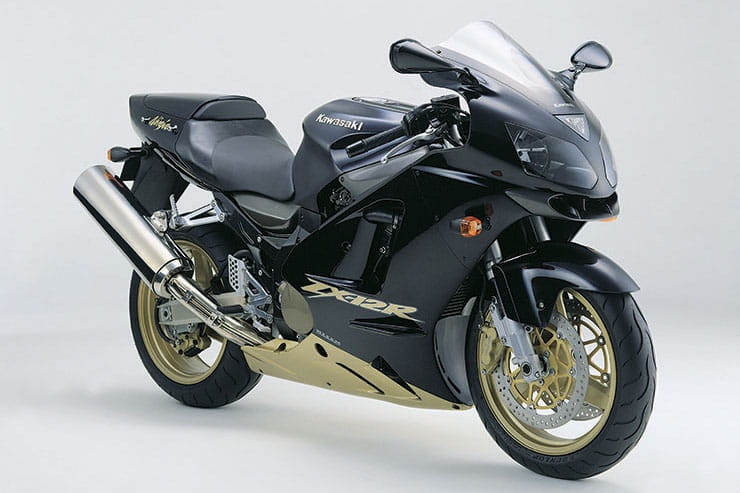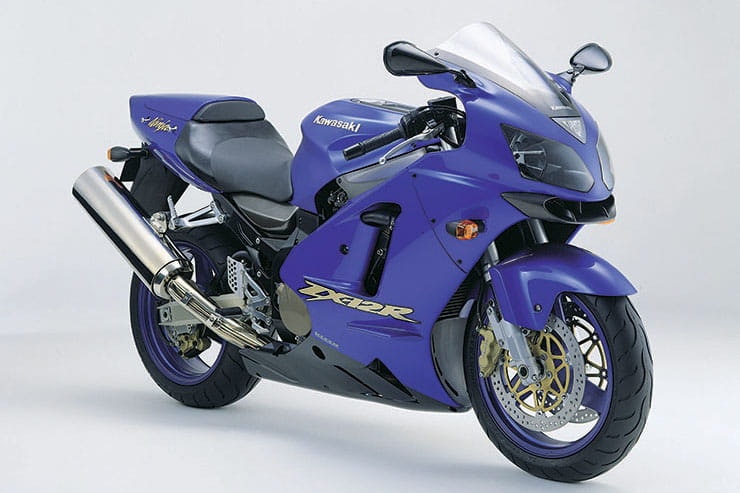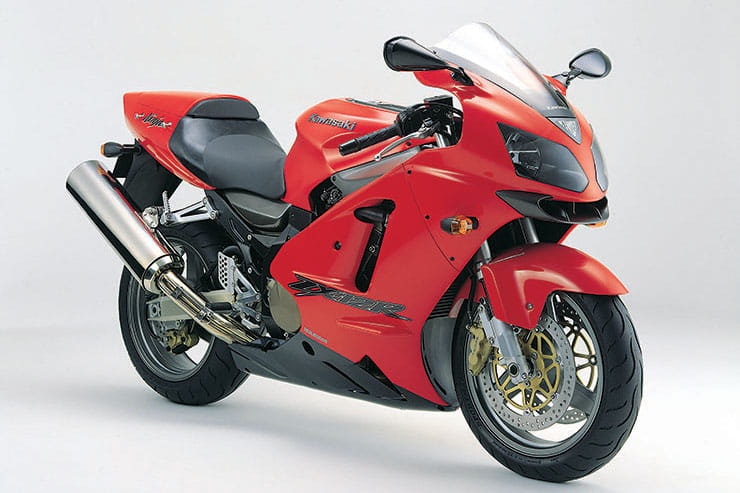Kawasaki Ninja ZX-12R (2000-2006) - Review & Buying Guide
By Jon Urry
Massively experienced road tester
29.08.2023
Price: £2500-£7000 | Power: 178bhp | Weight: 245kg | Overall BikeSocial Rating: 4/5
Unveiled in 2000, the Ninja ZX-12R was Kawasaki’s answer to the Suzuki Hayabusa. Generally faster than the Busa (depending on who you ask...), where Suzuki left the Busa largely unchanged (it was only really upgraded once from 1999 until 2020, twice if you count ABS and new calipers), Kawasaki released three generations of ZX-12R in just six short years before it was killed off. Not as popular as the Busa, the Ninja was hampered by the fact it never really knew what it wanted to be. Part sportsbike, part tourer, it hit an odd middle-ground and where the Busa shouted about its top speed and performance and sold on these facts, the ZX-12R stumbled and failed and was eventually replaced by the more touring-targeted ZZR1400 and GTR1400. Nowadays the Ninja ZX-12R represents a very good value hyperbike that still has more than enough performance to fry your brain while also boasting impressive reliability and not too bad comfort levels. It’s a bit too big and heavy to really be classed as a sportsbike but as a very rapid sporty tourer, it is a good option.
Kawasaki Ninja ZX-12R (2000-2006) Price
Prices for the Ninja ZX-12R tend to be quite low, which is a surprise considering what a monster of a bike you are buying. There again, it never built up the same kind of reputation for speed as the Hayabusa or ease of use as the Blackbird, so it tends to be somewhat overlooked. If you want an early model you can pick one up for as little as £2500 in a private sale with dealers looking to get closer to £3000-£3500. Go for the updated version (2002-2003) and you need to pay around £3000 for a private sale or just under £4000 in a dealership. As you would expect the final generation (2004-onwards) is the most sought-after and therefore expensive with its prices starting at £5000 and going up to £7000 for an absolute beauty. There are a few very low mileage bikes (sub-1000 miles) for sale but why would you pay £8000 (or even the £14,999 someone is trying to get!) for such a machine?
Stunning engine
Stable handling
Decent mile-munching ability
Costly to service
Heavy in bends
Lacks a bit of kerb-appeal
Engine and Performance
One word – wow! Kawasaki really know how to build a motor and the ZX-12R’s inline four is absolutely staggering in its performance. While still having a seemingly endless wave of torque, the Ninja also manages to add an extra element of excitement that the Busa (arguably) lacks through a bit of a Ninja-style kick at the top-end and also a far throatier airbox. It is an incredible motor and even now, nearly 20 years after it was first introduced, it will still leave you very impressed. But it isn’t perfect...
The first, and probably most annoying, aspect is its service intervals and associated costs. Due to its monocoque chassis, access is a nightmare and that means that even changing the air filter is a bit of a pain – let alone inspecting the valve clearances or changing spark plugs. That means that while a basic service (every 4000 miles) is a reasonable £150-£200, the major at 8000 miles, which includes a valve clearance check, is closer to £700. And it may even go higher if the clearances need altering. Always consider this and check a bike’s service history when buying used.
A few owners grumble about the fuel-injection’s response, which isn’t great but can be sorted out through an ECU remap or aftermarket fuelling module, and there is also the KLEEN system. An emission-reducing system, KLEEN injects clean air into the Ninja’s exhaust to help burn off unburn fuel. Some owners reckon it robs the bike of power and remove it (there are online guides), others say this is a waste of time. Just ask if it has been done as it is always best to know if someone has been in there and fiddled with the motor...
While there are three generations of ZX-12R, the engine has stayed pretty similar. The second generation (2002) added a heavier flywheel for better low speed response (look for the protruding air scoop) and the 2004 bike also had some engine updates but nothing to shout about. In terms of reliability, they are all the same and major issues are rare. You get the occasional reg/rec going down but that’s about it (there were a few recalls in its early days, these will have been sorted out) and as long as it has a good service history, you can buy with confidence.
Kawasaki Ninja ZX-12R (2000-2006) Handling & Suspension
Here is the quirk of the Ninja that in some ways was responsible for its lack of popularity. Unlike the Busa, which used a conventional sportsbike frame, the Ninja has a monocoque design of frame. The first mass-produced sportsbike to use such a design, it may have lots of benefits in terms of strength but it is also makes the Ninja a complete nightmare to work on, leading to high servicing costs (see above in the engine and performance section). Moving on from this, the rest of the Ninja is quite conventional with fully-adjustable suspension from the start and the option of either conventionally-mounted six-piston or on the final generation (2004-onwards) four-piston radially-mounted calipers. Although, to be fair, neither are great options...
Owners often complain about a lack of stopping power on the ZX-12R with the six-piston calipers coming in for the most criticism. Very prone to sticking pistons, they require regular cleaning and servicing to remain at the top of their game and even then, aren’t brilliant. When buying used, always check for warped discs (caused by a dragging pad) and as well as feeling for any pulsing through the brake lever, inspect the actual discs for warps, thickness and any blue-ing due to heat build-up. Rebuilding the calipers isn’t a huge drama with full rebuild kits only about £50 a side but it is worth upgrading them with stainless steel pistons, which will add about £100 to the bill. The four-piston calipers aren’t as bad but still can’t be neglected. And if the bike is running OE lines, always swap them for braided steel items (nice and easy to do as there is no ABS system), not only for safety but also to add a bit of extra stopping performance.
Although Kawasaki billed the ZX-12R as a sportsbike, on the go it does feel quite a big old bus. Heavy to turn (it weighs 245kg wet) the Ninja may be a touch more agile than a Hayabusa but it is still far from a sportsbike and certainly prioritises stability of agility – which is a good thing on such a fast machine. Pleasingly the OE suspension is fully-adjustable, which is helpful as dialling it in does make a difference, but by now the shock will probably need replacing. And always check the rear tyre, a square tyre really ruins the Ninja’s handling so see how much life it has left in it.
Comfort & Economy
Thanks to fairly tall gearing (some owners do alter it, standard is 18/46) the Ninja isn’t too bad when it comes to fuel economy. Expect to average just over 40mpg and you won’t be disappointed, which equates to a tank range of approaching 190 miles. A lot of owners seem able to squeeze more economy out of their bikes, but that is down to riding style. There again, about 200 miles is all you want to do on a Ninja in one hit as while the seat is lovely and deeply padded, it’s not the most comfortable of machines for straight line riding due to a low screen and also fairly sporty bars. If you want to mile-munch, a taller screen and even possibly bar-risers are a good option, however if the bike has risers fitted, always check they have been installed correctly. The issue with altering a bike’s bars is that items such as the brake lines and throttle cables can become stretched. With the engine running, turn the bars from one lock to another to see if the revs rise, which indicates the cable is being pulled, and with the engine off, see if the bars interfere with the fairing, tank or your knees on full lock. Ideally, also fully extend the forks to check the brake lines don’t become too tight.
Kawasaki Ninja ZX-12R (2000-2006) Equipment
When it comes to kit, you get very little on the ZX-12R. There are no safety assists, not even ABS, and it is all very analogue and basic. The most ‘tech heavy’ bike is the final generation, but only because it gets radial brakes where the other models have conventionally-mounted units, so it is hardly pushing the boat out!
In terms of extras, not that many ZX-12Rs get altered but the occasional bike may have a TRE (Timing Retard Eliminator) or a Speedo Healer to remove the 186mph top speed restriction (it can also be done via an ECU re-flash) but that’s about it. As the standard exhaust can is so huge, aftermarket units are common and so are free-breathing air filters, not for performance gains, more as they are reusable. A lot of owners add taller screens to improve the bike’s weather protection, heated grips are quite common with those who take the bike touring and so is crash protection. Overall, you can usually expect a ZX-12R to be pretty much standard, which is a good thing.
Kawasaki Ninja ZX-12R (2000-2006) Rivals
The Ninja ZX-12R is a hyperbike and that means owners tend to be experienced riders who want the ease of use you get from such a monster motor. It’s not a bike for newer riders!!!
Suzuki Hayabusa (2008-2020) | Approx Price: £4500-£9999
Power/Torque: 195bhp/113lb-ft | Weight: 220kg
Honda CBR1100XX Super Blackbird (1997-2005) | Approx Price: £1500-£5000
Power/Torque: 164bhp/88lb-ft | Weight: 223kg
BMW K1300S (2009-2016) | Approx Price: £3500-£10,000
Power/Torque: 175bhp/103lb-ft | Weight: 228kg
Kawasaki Ninja ZX-12R (2000-2006) Verdict
If you are talking punch for your pound, it is hard to argue against just how much performance you get with a Ninja ZX-12R for a very reasonable amount of money. A bike that certainly won’t appeal to everyone, the Ninja is the generally overlooked hyperbike of its era and while that can make it a bit forgettable, one ride will soon remind you what makes it so special. It’s not perfect, servicing costs and insurance can be high and it is a big old bus, but it is reliable, has a staggering motor and is very, very fast. If you fancy trying out a hyperbike, it’s a bit classier than a Hayabusa and not as tech-heavy as the K1200/1300S, giving it a pleasingly analogue feel and authentic Ninja spirit.
If you’d like to chat about this article or anything else biking related, join us and thousands of other riders at the Bennetts BikeSocial Facebook page.
Kawasaki Ninja ZX-12R (2000-2006) – Technical Specification
Looking for motorcycle insurance? Get a quote for this motorbike with Bennetts bike insurance


